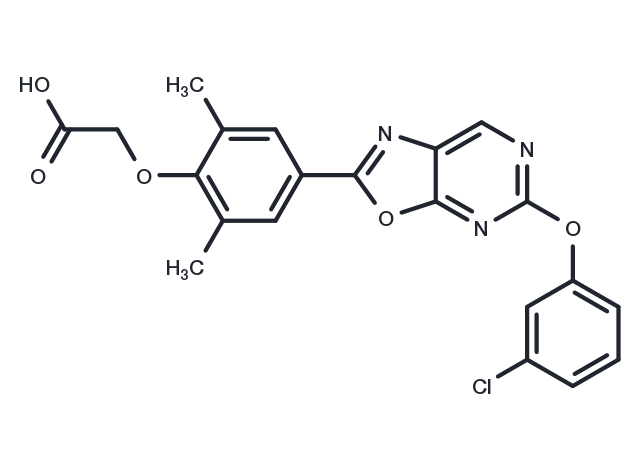Powder: -20°C for 3 years | In solvent: -80°C for 1 year


SAR247799 (S1P1 agonist 3) is an orally-active, selective G-protein-biased agonist for the sphingosine-1 phosphate receptor-1 (S1P1). It demonstrates EC50 values ranging from 12.6 to 493 nM in S1P1-overexpressing cells and HUVECs. SAR247799 holds promise as a valuable tool for investigating endothelial protection, particularly in the context of type-2 diabetes and metabolic syndrome[4].

| Description | SAR247799 (S1P1 agonist 3) is an orally-active, selective G-protein-biased agonist for the sphingosine-1 phosphate receptor-1 (S1P1). It demonstrates EC50 values ranging from 12.6 to 493 nM in S1P1-overexpressing cells and HUVECs. SAR247799 holds promise as a valuable tool for investigating endothelial protection, particularly in the context of type-2 diabetes and metabolic syndrome[4]. |
| Targets&IC50 | S1PR1:12.6-493 nM (EC50) |
| In vitro | SAR247799, at varying concentrations (0, 0.003, 0.01, 0.03, 0.1, 0.3, 1, 3, 10 μM; for 10 minutes), triggers a dose-dependent phosphorylation of extracellular-regulated kinase-1/2 (Erk1/2) and protein kinase B (Akt) in HUVECs[1]. Furthermore, at concentrations ranging from 0 to 10 μM over 8 minutes, it prompts a dose-dependent change in impedance in HUVECs[1]. At a concentration of 1 μM and first exposure, SAR247799 does not induce desensitization as illustrated by the Ca2+ flux assay in S1P1-Chinese hamster ovary (CHO) cells[1]. |
| In vivo | SAR247799 was investigated in various models for its potential therapeutic effects. Administered orally one hour prior to inducing renal occlusion at doses of 1 and 3 mg/kg, it significantly mitigated the severity of ischemia/reperfusion (I/R)–induced acute kidney injury by dose-dependently decreasing serum creatinine and urea levels, protecting renal proximal tubules from necrosis, and reducing interstitial hemorrhage development. Furthermore, intravenous doses of SAR247799 (0.3, 1, 3 mg/kg) enhanced coronary conductance ratio in a pig model of coronary endothelial dysfunction, indicating improved coronary flow. Pharmacokinetic analysis revealed that the exposure of SAR247799, assessed by peak plasma concentration (Cmax) and area under the concentration-time curve (AUC), increased with dose across tested ranges, demonstrating dose-dependent pharmacokinetics in pigs. The study utilized acute kidney injury rat models and farm pigs to evaluate the compound's efficacy and pharmacokinetics, highlighting its potential in treating renal injuries and coronary endothelial dysfunction without providing detailed pharmacokinetic values for brevity and focus on its therapeutic applications. |
| Synonyms | SAR247799, S1P1 agonist 3 |
| Molecular Weight | 425.83 |
| Formula | C21H16ClN3O5 |
| CAS No. | 1315311-14-8 |
Powder: -20°C for 3 years | In solvent: -80°C for 1 year
You can also refer to dose conversion for different animals. More
bottom
Please see Inhibitor Handling Instructions for more frequently ask questions. Topics include: how to prepare stock solutions, how to store products, and cautions on cell-based assays & animal experiments, etc.
SAR247799 1315311-14-8 SAR 247799 S1P1 agonist 3 SAR-247799 inhibitor inhibit
